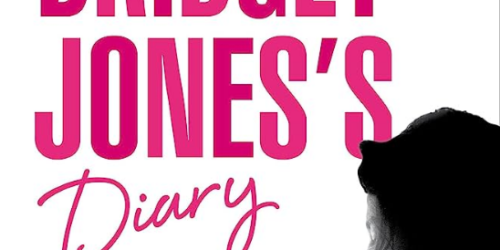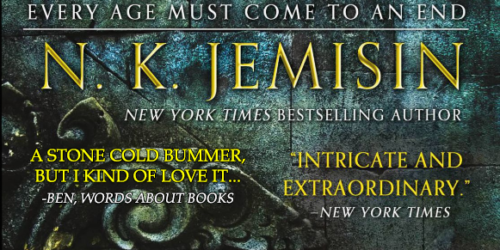Demon Slayer: Kimetsu no Yaiba Manga Spoiler Review
First and foremost, as the title suggests, there will be spoilers for the entirety of the Demon Slayer: Kimetsu no Yaiba series. This is a review about the manga, not the anime adaptation. The manga has been finished for almost 2-years at this point, but I know there are people who may stumble upon this only having watched the anime which is ongoing.
If you’re interested in whether or not I liked it without getting into spoilers. The short version of this review is that I’d give it a 3.5 out of 5, but expect the anime to be a 4.5 out of 5. I like the story, but there were some missed opportunities to make me love the story. The author seemed uninterested in several key plot threads which leads to an underwhelming conclusion that lacks the impressive visuals that ufotable has brought to the animation.
If you scroll past this image then you enter into spoiler territory.
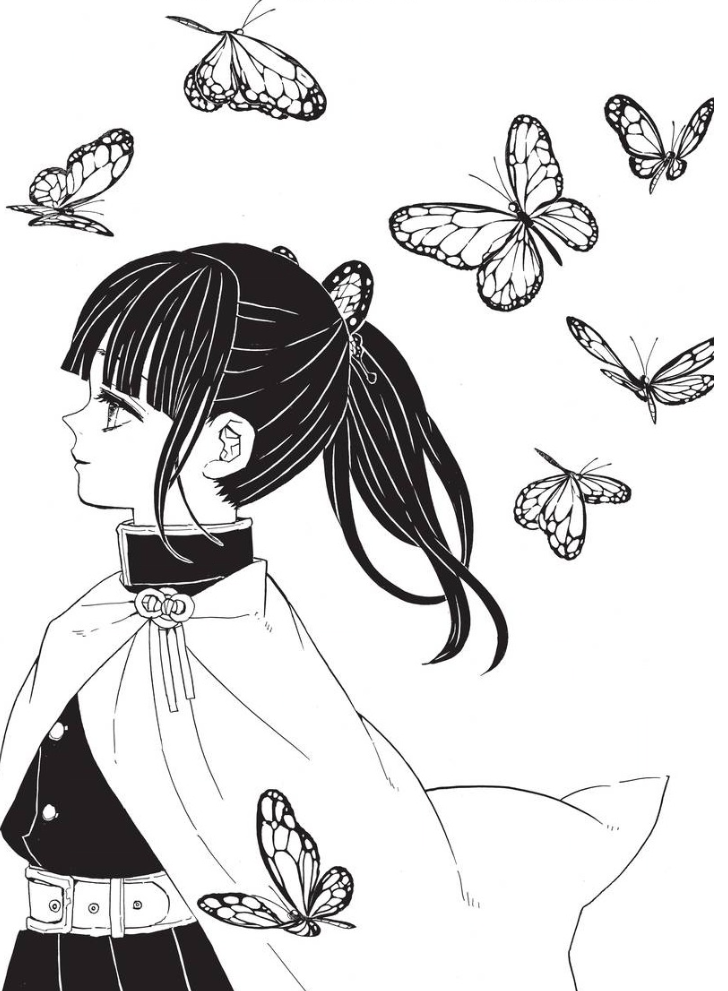
The Shonen Manga Grading Curve
The mission of Words About Books is to read a lot and to read widely for the purpose of analyzing what works and what does not work in storytelling. We focus primarily on novels and short stories, but we also dabble in non-fiction and graphic novels as well. I’ve been a fan of manga in particular for a very long time. With that said, I have a kind of complicated relationship with the western anime/manga consuming audience. I think there is a tendency among some readers to fetishize things from Japan, and by that I mean, to accord them some special credibility or status simply because they are “exotic.” I don’t like the idea that its being from Japan is a determining factor in choosing whether or not to read a particular comic book. If you’re interested in hearing me ramble on about this relationship at length, I co-host another podcast: That Time I Got Reincarnated in the Same World as an Anime Podcaster.
When it comes to reviewing a graphic novel; however, I do think it is important to point out the conditions under which it is written. Especially when those conditions are very different from the usual books and short stories that we discuss on Words About Books. Most Shonen Manga is originally serialized and published in weekly or monthly magazines in Japan. Chapters of Kimetsu no Yaiba were usually 24-pages in length. That’s 24-pages written, drawn, and inked by a single Mangaka (author/artist) and a small team of assistants, each week.
All serialized fiction suffers from some of the same problems. There’s filler, dropped plot threads, continuity errors, retcons, deus ex machina, etc., etc. Weekly manga magazines put their creators in a special kind of pressure cooker that exacerbates all of these problems. Pacing is all over the place. Retcons become legendary in-jokes amongst fans. To some extent, you have to ignore these things and just kind of enjoy the ride. It’s understood among readers that manga authors who write themselves into the occasional hole may not have much time to skillfully dig themselves out. These are hazards of the medium and should be taken into consideration when comparing with stories developed in different environments.
I wanted to make it clear that I understand and accept many of these imperfections when I read manga. For me, what makes a good manga is a pay off that makes me forget about all the stumbles we took along the way. When it comes to Demon Slayer, Gotouge has a talent for plucking heart strings that let’s the reader look past the frequent handwaving away of character development and pacing. At least, it does until the last 10 chapters or so. It becomes rapidly apparent that Gotouge wrote many checks that the conclusion was not going to be able to cash. Even with the shonen manga grading curve in mind, I still have some problems with the way Demon Slayer executes its story.
A Loosely Connected Anthology of Short Tragedies

The emotional core of the series is its main character Tanjiro Kamado. Tanjiro is from a family of humble charcoal sellers living in Taisho Era (Jul 30, 1912 – Dec 25, 1926) Japan. After an overnight trip into town, Tanjiro returns to find his family brutally slain. The sole survivor is his sister Nezuko, but Nezuko has been turned into a demon. Nezuko now possesses super human strength and healing abilities. She has lost all sense of self and attacks Tanjiro.
Tanjiro is begging Nezuko to come to her senses when a man with a katana shows up claiming to be a demon slayer and demands that Tanjiro stands aside. Tanjiro fights to protect his sister. The demon slayer easily forces Tanjiro aside, but is surprised to find the demon Nezuko step in to protect her older brother. The demon slayer senses something different about these two.
Nezuko, despite struggling at first, seems able to control her urge to consume human flesh. This is something that was once thought impossible for a demon. Tanjiro and Nezuko set off on a quest to join the demon slayers, and with their help, find a cure to Nezuko’s affliction. If along the way they should happen to rid the world of the evil Kibutsuji Muzan, the progenitor of all demons, all the better.
The rest of the series will follow Tanjiro and Nezuko as they search for a cure. Along the way they will meet The Hashira, accomplished swordsmen and women who have mastered various breathing techniques that allow them to go toe-to-toe with the most powerful demons. They will do battle with The Twelve Kizuki, unfathomably powerful demons who have survived centuries of war with The Hashira.
What makes Demon Slayer refreshing is its protagonist. Tanjiro Kamado is a gentle soul with a high level of emotional intelligence, impeccable manners, and an almost super human capacity for forgiveness and understanding. He encourages and uplifts everyone he meets, friend or foe. While other demon slayers fight with hate in their hearts, Tanjiro fights with sympathy for the human beings the demons once were. In many ways, it is his empathy that allows him to turn the tide in a centuries long stalemate between the Demon Slayers and the evil progenitor demon Muzan Kibutsuji.
One of the reasons Demon Slayer has been such a mega hit is because of it’s heightened emotional awareness in a genre that is overcrowded with manly men screaming and punching each other ever harder until the readers lose interest. But even this more emotionally complex take on a shonen battler starts to have diminishing returns after the formula is repeated too many times.
Every character in Demon Slayer has a tragic backstory. Now, I’m afraid that you may have just read that previous sentence and understood it to mean “a lot of characters in Demon Slayer have a tragic back story.” Let me be very clear. Every named character in Demon Slayer: Kimetsu no Yaiba has a tragic back story.
Demon Slayer story arcs follow a pattern:
- Introduce characters
- Introduce conflict
- Hint at tragic back story
- Action
- More back story
- Climax of action
- Climax of tragic back story
- Pleasant reunion with relatives in afterlife to make it all better.
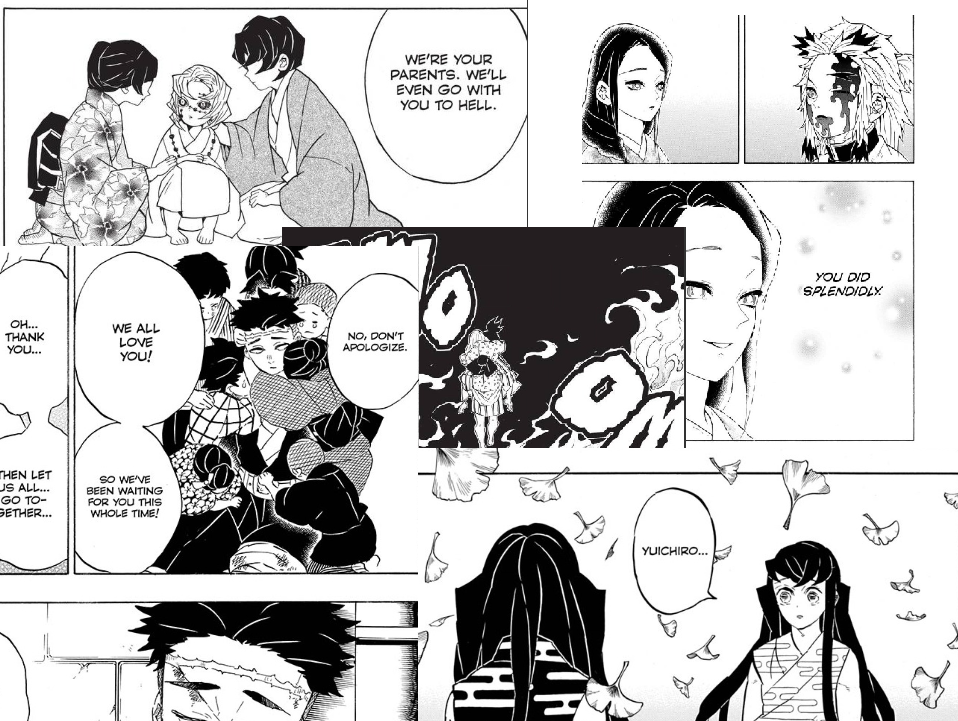
Sometimes the tragic background fits neatly into the story. Sometimes it does not. Sometimes you will get a whole chapter that is nothing but the tragic back story of a villain that was introduced a few chapters earlier. Sometimes you couldn’t care less about the demon’s life story and you just want to know if a main character survived the battle. I read this manga well after it was completed, and it was incredibly frustrating how often the action would be stopped dead just to share the tragic origin of a character the audience had very little time to form a connection with. I can only imagine if I went into those chapters knowing I would have to wait a week to get the part of the story I cared about.
The tragic back stories are not filler. They don’t exist just to tread water while the author works on more complicated chapters. These are obviously parts of the story that Gotouge cared about. They’re not even bad stories, they’re just so clumsily woven in to the narrative that I came to dread them after a while. Once I figured out the formula I could predict exactly when we would be getting the flashback chapter to the demon’s tragic back story. Once you realize that a demon is on the cusp of defeat you know that the story is about to stop dead so that we can learn why you should actually feel bad for that demon and hate Muzan even more than you already do. It begins to feel like an emotional manipulation.
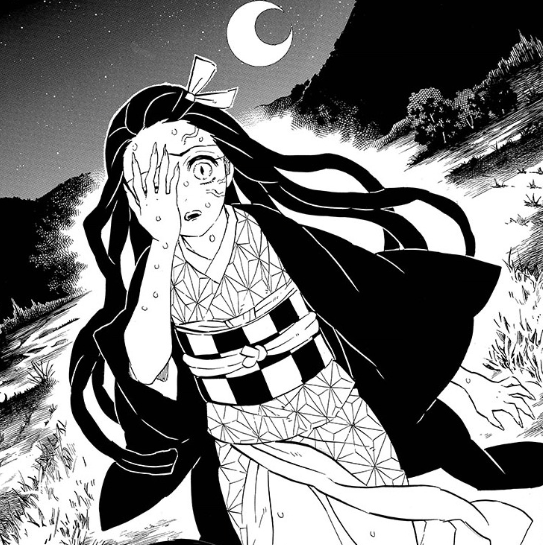
Sprint to the Finish
Early in the manga the story has plenty of room to breathe and the formula isn’t quite so bluntly executed. The pace of the story accelerates rapidly at around the 50% mark. On one hand, this avoids a trap that many serialized stories fall into: overstaying their welcome. On the other hand, this sprint to the finish results in major plot points that have existed since the beginning of the series being given unsatisfying or incomplete resolutions. Some plot points are resolved off screen, or simply never addressed at all. The most glaring example that comes to mind is Nezuko’s cure. The entire reason we are here. The cure is developed off screen by a character we’ve seen barely twice and it is also administered off screen.
According to the Kimetsu no Yaiba fan wiki, there are 11 major story arcs in the series.
- 1 Final Selection Arc
- 2 First Mission Arc
- 3 Asakusa Arc
- 4 Tsuzumi Mansion Arc
- 5 Natagumo Mountain Arc
- 6 Rehabilitation Training Arc
- 7 Mugen Train Arc
- 8 Entertainment District Arc
- 9 Swordsmith Village Arc
- 10 Hashira Training Arc
- 11 Final Battle Arc
- 11.1 Infinity Castle Arc
- 11.2 Sunrise Countdown Arc
The Final Battle Arc takes up roughly one third of the entire page count of the manga. Gotouge’s primary focus is on exploring the characters’ traumas and illustrating battles that act as a metaphor for resolving that trauma. The battles are admittedly very interesting. The downside is that set up is often often sacrificed in the name of the battle that pays it off. For example, we are simply told that Doma is the demon that killed Shinobu’s sister. Shinobu’s anger over a demon having killed her sister is something that has been built up for quite a while, but until the very moment Shinobu see’s Doma we have no idea that he’s the one who did it. Even more egregious, Doma is the demon who killed Inosuke’s mother. This demon is a key piece to closing out two pretty major character arcs in the story and we only learn these connections in quick flashbacks during the battle. Inosuke wasn’t even aware his mother had been killed by a demon when the fight started.
Just a few of the plot points that are never resolved include:
- Why is Nezuko different?
- Who was the doctor that turned Muzan into a demon?
- Why are Nezuko and Tanjiro able to withstand the sun?
- Is there any purpose to the niichirin swords changing color? Why were Tanjiro and Yoriichi’s swords black? Why do swordsmen with black swords tend to die?
- The Blue Spider Lilly
- How was Tamayo able to create a demon? Why does that demon survive both her’s and Muzan’s deaths?
Demon Slayer has too many characters with too many tragic back stories to tell. Too many important plot points wind up skipped in an effort to wrap the story up quickly. The manga either needed 100 more chapters or it needed to halve the number of characters.
I’ve criticized stories in the past for getting too into the weeds on world building and not focusing on the human element. Demon Slayer certainly spends more time on the tragic human elements of its story, but a tragic vignette doesn’t automatically make a character compelling. It can make a character more sympathetic to readers, but non-stop tragedy becomes exhausting. Ignoring mysteries that were set up in the lore in favor of adding more characters with more tragic backstories while simultaneously insisting on a relatively limited number of chapters was not the optimal choice.
The Last Chapter Is a Cop Out…
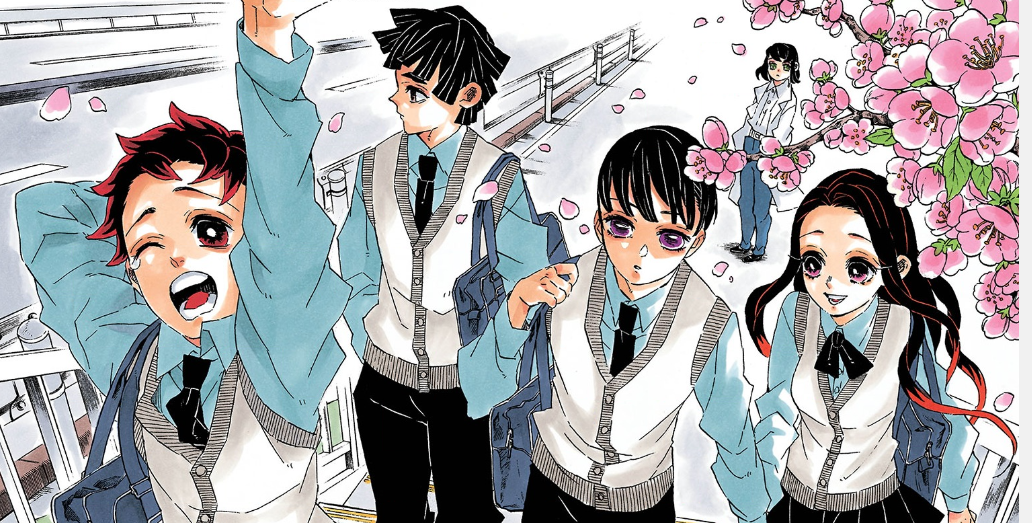
There is a particular narrative device that is used throughout Demon Slayer that I really don’t care for. For lack of a better phrase, I’m going to call it the “Let God Sort Them Out” maneuver. It’s when after a lot of horrible stuff happens and a bunch of people die, you want to soften the blow. So you imply that they’re moving on to a better place. Usually this is done by showing the character being welcomed into the afterlife by loved ones.
The final chapter of demon slayer shows all of the demon slayers reborn in modern Japan where they are all friends and are able to enjoy a normal life. I hated this. It would have been so much more meaningful to have the final chapter show what happened to the Demon Slayer corps after Muzan died. They do show the final meeting of the Hashira where the corps is officially disbanded, but that left me with a very hollow feeling. The corps was everything to most of the people in it. I wanted to know that they were ok. I wanted closure on the characters I cared about. Whatever this last chapter was, it wasn’t that.
Wow, that’s a lot of whining. Is there anything you liked?
Demon Slayer gets a lot right. Part of the reason I focused on some of the negative aspects of the story in this review is because Demon Slayer receives near universal praise. I feel that most of what’s good about it has already been discussed at length and that I don’t have very much to add that hasn’t already been said. With that said, I would like to call attention to one very important thing that Demon Slayer does well.
Gotouge understands that battles in stories are more about the emotional struggles between characters than they are about cool choreography. This isn’t to say that Demon Slayer doesn’t have cool choreography, but it doesn’t rely solely on that. Demon Slayer invokes tragedy to make sure that every battle is an emotionally charged struggle between trauma and healing. Tanjiro knows that the demons can’t continue to live as they are, but that does not mean he hates them. For Tanjiro, and the demons he kills, their defeat is a release from the eternal hell that Muzan has inflicted upon them. Because of this, the emotional core of the story is rock solid.
As an emotional ride, designed to get the blood pumping and the tears flowing, Demon Slayer is as good as it gets. For this reason, the ufotable anime is even better than the manga in my opinion. The anime’s use of special effects and music enhances everything that is great about Demon Slayer. Even I must admit, all of these intellectual complaints I have about story structure and pacing go out of the window when I hear “Tanjiro no Uta” start playing and the water dragon turns to fire as Tanjiro screams “Hinokami Kagura…ENBU!”


